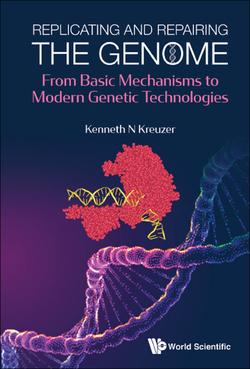Читать книгу Replicating And Repairing The Genome: From Basic Mechanisms To Modern Genetic Technologies - Kenneth N Kreuzer - Страница 16
На сайте Литреса книга снята с продажи.
How did they test that?
The base composition of DNA and Chargaff’s rule
ОглавлениеStudies of DNA in the first half of the 1900s uncovered the basic units of the molecule, namely the sugar, phosphate, and four distinct bases (for a fascinating review of this period of research, see Frixione and Ruiz-Zamarripa, 2019). At the time, DNA was not suspected to be the genetic material — it seemed too simple. The dominant model was the “tetranucleotide hypothesis,” in which the four bases were linked to each other in a simple ring structure. This structural proposal was based on crude data that suggested roughly equal amounts of the four bases in preparations of DNA. Erwin Chargaff and his colleagues conducted very careful and detailed studies that disproved this hypothesis and provided key evidence that helped Watson and Crick arrive at the correct structure of duplex DNA. Chargaff and his associates meticulously purified DNA from various sources, carefully eliminating RNA contamination. Next, they hydrolyzed the DNA samples and determined the fractions of each of the four bases in the resulting mixtures. Without going into the chemical details, the determinations were done as follows. First, the base mixtures were subjected to paper chromatography, in which the various bases migrated to different positions along paper strips soaked in various chemical solutions. Four small areas on the paper strips, containing each of the purified bases, were cut out, and the four bases were eluted into separate test tubes. These were then analyzed by UV spectroscopy, which provided the adsorption maxima (revealing base identity) and intensities (revealing amounts). In one study, Chargaff et al. (1952) measured the base composition from sperm DNA isolated from four different sea urchin species (Table 1.1). In each of the four samples, the proportions of adenine and thymine were equal (within experimental error), as were the proportions of guanine and cytosine (Table 1.1). However, the proportions of other pairs of bases were clearly disparate. This data clearly disprove the tetranucleotide hypothesis mentioned above. The equality of adenine/thymine and guanine/cytosine, which was seen in disparate species (Table 1.2), is the socalled “Chargaff rule.”
Table 1.1.Base content of sea urchin sperm DNAs.
Base values are in mole percent; data from Chargaff et al. (1952).
Table 1.2.Base content of diverse species.
Base values are in mole percent; data from Chargaff as cited in Bansal (2003).
1The total number of human cells is difficult to estimate and somewhat controversial, but a recent compilation put the number at about 37 trillion. About 80% of human cells are red blood cells that lack a nucleus, leaving about 7 trillion nucleuscontaining cells.
2When discussing DNA or a particular DNA sequence, the nucleotide residues are often referred to simply as the base designations A, G, C, and T, rather than the more cumbersome dA, dG, dC, or dT, and without explicitly indicating the phosphate linkages. The deoxy designations will be used in situations where both RNA and DNA nucleotide residues are relevant and need to be distinguished.
3See Okazaki et al. (1968) in Further Reading at the end of this chapter.
